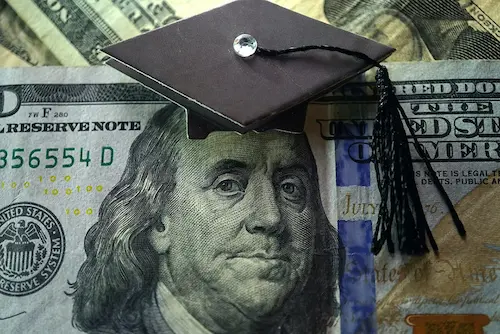
Impact of Student Loan Debt on Families
The $1.7 trillion student loan debt problem affects all generations equally – it is not just a millennial or Gen Z problem. Not only high school kids who are just beginning to build their lives have been negatively impacted by the debt, but also parents or grandparents who took out loans to support a loved one through college but are now close to retirement. According to a 2020 JPMorgan Chase & Co. Institute analysis (which examined the student loan debt of more than 300,000 Chase Bank customers), nearly 40% of individuals engaging in student loan repayment are helping someone else pay down their student loan debt. The vast majority of these individuals do not have their own student loan debt, but still nearly one-third (31%) of these individuals appear to be making student loan payments for themselves as well as someone else.
The burden of student loan debt falls heavily on low-income students and their families, and the dread of further debt deters them from pursuing higher education, such as a bachelor’s or master’s degree. Due to the high cost of higher education, low-income students must choose carefully whether to enroll in college at all. These families are caught in a cycle of poverty that prevents them from pursuing further education and keeps them in low-paying occupations for years and possibly generations.
Impact of Student Loan Debt on Students
Student loan debt significantly impacts a student’s life, since its repercussions continue to be felt decades after graduating from college. Having a lot of debt can make people anxious and stressed out, and having to repay student loans may compel them to put off major life events. Instead of waiting to land their dream career, recent graduates frequently have to settle for lower-paying, lower-skill employment in order to start making their loan payments each month. A study conducted by the American Student Association found that nearly 50% of graduates felt that their student loan debt prevented them from advancing their professions. Student loan debt also decreases their net worth, which can make it difficult to make significant purchases, get approved for additional loans, etc.
Student loan debt can also delay the ability of a borrower to buy a home or drive an automobile, for example. Managing a house payment, vehicle loan payment, and student loan payment all at once can be difficult. Additionally, if one is unable to make timely and regular payments on their student loans, having debt may make it difficult to qualify for a mortgage or vehicle loan due to having too much debt and a low credit score. A Federal Reserve study demonstrates how student loan debt affects homeownership rates – on average, homeownership rates fall by 1.5% for every 10% increase in student loan debt. Furthermore, student loan debt significantly contributes to the postponement of life goals like pursuing higher education, getting married, and even starting a family, unless there is growth and advancement in earnings; otherwise, the majority of life is spent trying to bridge financial gaps. Additionally, saving, investing, planning, and strategizing for retirement or other future financial needs is difficult or even impossible.
Impact of Student Loan Debt on the Economy
The Federal Student Loan Program was established in 1965 to increase access to and the scope of higher education. The majority of financial aid for students pursuing higher education comes from these loans. Federal student debt has skyrocketed in recent years, rising by 144% since 2007, as a result of rising loan balances, low repayment rates, and loan defaults over time, totaling $1.62 trillion (more than the GDP of nations like Australia, Spain, and Mexico). By the end of 2020, the federal student loan portfolio represented 7.3% of the GDP of the United States. When you consider how much debt the U.S. government already carries, you can see why this possible financial impact is worrisome.
Small businesses are crucial to the American economy because they generate two-thirds of all net new jobs and are the engine of American innovation and competitiveness. According to a 2019 SBA analysis, small companies were responsible for 44% of the country’s economic activity. However, one factor contributing to the eventual fall of this contribution is the rising student loan debt. A CNBC analysis claims that starting a business is 11% less likely for someone with $30,000 in student loan debt than for someone who graduated debt-free. People who have college loans find it more difficult to obtain bank credit, and they also have less savings to invest in a new venture. Additionally, given that they must make monthly loan payments, they might be unwilling to take the financial risk of starting a new business.
Student loan borrowers are considered “poor” consumers in the United States, where consumer spending accounts for 70% of GDP. Economic growth can be greatly slowed or prevented if millions of people divert their expendable income to debt payments, which is the case for millions of student loan borrowers. Less money is kept in the bank or saved due to the ongoing financial responsibility of student loan payments. When paying off student loans, a person will spend money primarily on necessities and will have less money available for purchases that support the economy, businesses, and labor.
Additionally, the housing market is hampered by student loan debt. Higher debt balances among those with student loans raises the risk of borrowers becoming “delinquent,” or falling behind on their payments, which lowers credit scores and makes it more challenging for them to qualify for a mortgage loan. According to the Federal Reserve’s data released in January 2019, the percentage of persons aged 24 to 32 who are homeowners fell by 9% from 2005 to 2014, of which student loan debt likely accounts for approximately 2% of the decrease. Due to the weight of student loan debt, this percentage is currently only at 36%. In other words, 400,000 people might have bought a home between 2005 and 2014, but chose not to because of their student loan debt. Another study found that for public four-year college students in their mid-20s, a $1,000 increase in student loan debt caused a 1.5 percentage point decrease in homeownership rates, which is also equivalent to an average delay of 2.5 months in attaining homeownership.
Debt from student loans is a form of negative wealth because it consumes funds that could be used to save, buy a house, or invest in the stock market, all of which would improve wealth. Therefore, student debt prevents certain borrowers from accumulating money for future generations, thereby escalating the current wealth gap.
A generation ago, the government, educational system, and society came together to create a risk-free higher education by lowering tuition costs, allowing students to fully benefit from their learning and college experience, and paying it back in the form of increased tax revenue. However, over time, this risk has shifted directly onto the students, as seen by the circumstances surrounding the student loan crisis. To make higher education accessible, financially feasible, and risk-free for all, it is clear that public-private sector collaboration is key, and that all relevant parties must work together to develop an inclusive and equitable solution to this crisis.


 Raj Mehta – Financial Education Instructor
Raj Mehta – Financial Education Instructor